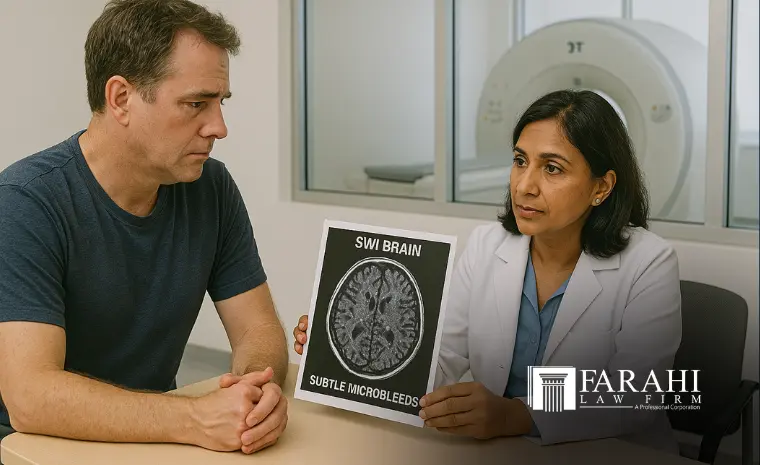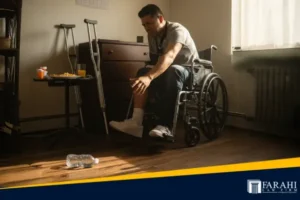Summary
Susceptibility Weighted Imaging (SWI) is a powerful MRI sequence that detects microbleeds, often invisible on a CT scan. It is especially valuable for identifying traumatic brain injuries (TBI) after an accident. This advanced brain imaging is crucial in diagnosis, prognosis, and providing medical evidence under California law.
Table of Contents
Brain injuries are among the most complex consequences of motor vehicle accidents, falls, or collisions. For accident victims in California, identifying hidden trauma can make the difference between proper treatment and lifelong disability.
Susceptibility Weighted Imaging (SWI), an advanced form of magnetic resonance imaging, has transformed how doctors and lawyers uncover brain trauma. As cases of TBI after an accident rise, understanding SWI’s role in diagnosis and litigation becomes essential.
Keep reading to learn how this technology affects medical recovery and legal claims.
What Is SWI and How Does It Work?

Susceptibility-weighted imaging (SWI) is an advanced MRI technique that uses 3D gradient echo imaging to detect subtle brain changes. Unlike a CT scan, which can miss small bleeds, SWI improves the visibility of microhemorrhages and diffuse axonal injury (DAI). This makes SWI one of the most accurate tools for detecting hidden lesions in brain function.
According to an NCBI study, diffuse axonal injury commonly occurs in severe TBI because of shearing forces during rapid head movements. SWI was 3 to 6 times more sensitive than traditional MRI scans in detecting hemorrhagic lesions, which are small areas of bleeding within the brain. Identifying these lesions makes SWI essential for patients and attorneys.
Why SWI Is Key for Detecting Microbleeds
- Detects injuries invisible on standard scans
- Identifies small punctate hemorrhages in deep brain tissue
- Reveals damage in critical regions such as the corpus callosum and brainstem
- Provides strong medical evidence in cases of wrongful death or permanent disability
In Bakersfield, near Truxtun Avenue and the busy intersections of Highway 99, many auto accidents and truck accidents result in patients requiring advanced diagnostics like SWI to confirm the extent of brain trauma.
Common Injury Patterns in TBI
SWI reveals characteristic injury patterns often seen in:
- Motor vehicle accidents
- Pedestrian accidents
- Slip and Fall Accidents
- Sports-related concussions
- Non-accidental trauma
These injury patterns often include:
- Deep subcortical hemorrhages
- Shearing injury at gray-white junctions
- Brainstem microbleeds linked to long-term prognosis
How SWI Results Connect to Symptoms and Prognosis
SWI findings often correspond with actual symptoms such as:
- Cognitive impairment affecting the functions of the brain
- Persistent headaches
- Mood and behavioral changes
- Seizures or loss of consciousness
The severity of lesions detected may determine long-term care needs, ongoing medical bills, and whether the injury qualifies as a severe TBI requiring lifetime medical expenses.
Role of SWI Evidence in Court
For Bakersfield brain injury attorneys, SWI plays a critical role in litigation:
- Provides objective proof of injury when CT scans are inconclusive
- Strengthens claims for damages in personal injury and wrongful death lawsuits
- Counters challenges from insurance companies attempting to minimize payouts
- Demonstrates brain trauma caused by auto accidents, truck accidents, or falls
Attorneys often present SWI results to juries as compelling medical evidence, showing how even microscopic injuries can drastically impact daily life.
Legal and Financial Implications in Bakersfield, CA
Under California law, victims of TBI after an accident may pursue compensation for:
- Past and future medical expenses
- Lost wages and reduced earning capacity
- Pain and suffering
- Costs associated with long-term care
Many victims worry about the affordability of legal help. Fortunately, most Bakersfield brain injury attorneys operate on a contingency fee basis, meaning clients pay nothing upfront unless compensation is secured.
Steps Following a Suspected Brain Injury
If you or a loved one suspects a brain injury after a car accident or fall, take these steps:
- Seek immediate medical evaluation with MRI scans, including SWI when possible.
- Document all symptoms and medical expenses carefully.
- Consult a top-rated brain injury lawyer in Bakersfield for guidance.
- Avoid direct negotiations with insurance companies without legal representation.
- Preserve all medical evidence to support your claim.
FAQs
SWI can detect microbleeds that CT scans often miss, making it more accurate in diagnosing brain trauma.
Yes. SWI results are often presented as medical evidence to prove the severity of brain injuries in court.
No. Susceptibility-weighted imaging is useful for mild and severe cases, as it detects subtle changes in brain function.
Many policies do, but coverage depends on the provider. An attorney can help ensure medical bills are included in TBI claims.
Get Legal Help Backed by SWI in Bakersfield
Susceptibility-weighted imaging is more than just a diagnostic tool—it is a lifeline for patients and families navigating the aftermath of auto, pedestrian, and slip-and-fall accidents. By revealing hidden brain injuries, SWI guides treatment and strengthens legal claims.
If you or a loved one is facing brain trauma from motor vehicle accidents, connect with a top-rated brain injury lawyer in Bakersfield. Contact us today for a free consultation and let experienced attorneys fight for the medical care you need and the money you deserve.



